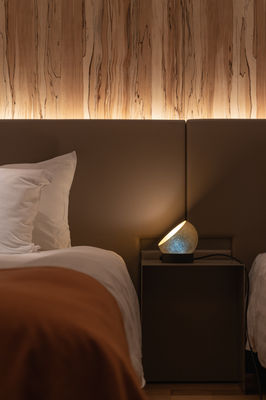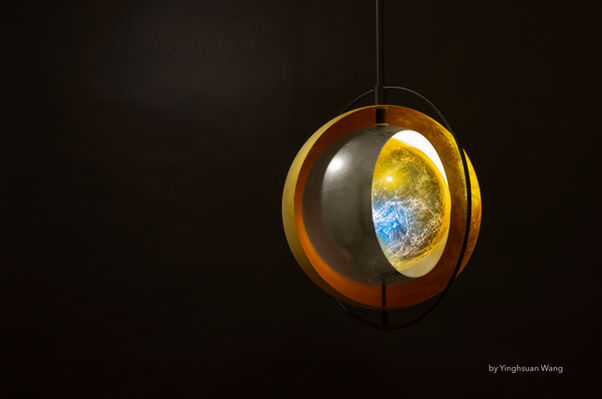
"GOLDBLU lamp" is a series of lighting products featuring the phenomenon of light transmitted through thin gold leaf appears to be blue-green as gold has the property of absorbing blue and green light.
The series of lamps are designed by 3 different designers based on this same concept.
LESS THAN 600 is the one of the new lighting product series "GOLDBLU lamp" which was borned by Japanese be-spoke lighting product factory "Yahiro electronics Inc" and Japanese Gold leaf brand "GOLDEN VALOR".
This lighting product is a freestanding lamp which is inspired by a Japanese traditional craft "Kanazawa Gold Leaf" with application of modern lighting technologies such as a dimmer LED.
These features enable to carry anywhere like shelf, bed side, low table, outdoor and so on.
It allows to have a mystical moment by dual aspect of the shining golden reflector inside, and the sphere emitting slightly blue-green light outside.
Client : Yahiro Electronics Co.,LTD, Golden Valor Inc.,
Job Part : Branding Strategy, Project Manager, Product Design, and Visual Communications.
GOLDBLU lamp series
& LESS THAN 600
WHY / context

Courtesy of GOLDEN VALOR Inc.,

Courtesy of Yahiro Electronics CO.,LTD
Japanese traditional craft "Kanazawa Gold & Silver Leaf" have been faced with decreasing demand due to changed lifestyles and alternative techniques. My client of gold leaf brand "GOLDEN VALOR" of which parent company was established in 140 years ago also have been faced with this.
As well as, most of subcontract manufacturers in Japan such like my another client which is bespoke lighting factory, "Yahiro Electronics CO., Ltd", have felt a fear of terminating a contract by primary contractor due to such a hard times.
HOW / application

In terms of brand strategy, they required to rebuild proper worthinesses by making the most of their original identity.
Luckily, we found that a pretty strong point that gold leaf which was made in Kanazawa, Japan exclusively has an unique charactor that it absorbs lights of blue-to-green wavelength due to exquisite thickness.
By this natural light phenomenon, we could find a best connectivity between its refined bespoke lighting factory with its gold leaf.
Undoubtedly , this lighting product series "GOLDBLU lamp" were founded that collaboration with two different craftsmens in order to make the most of its unique charactor.
WHAT / implementation
Each lamp was designed by 3 designers based on the same concept.
By applying this unique feature of Japanese traditional gold leaf craft to modern lifestyles, it aims to solve the critical issue of decline in Japan’s traditional gold Leaf industry.
Through this collection, users can be aware of the mystic beauty of natural gold and traditional refined craftsmanship in their everyday lives.
Product Family
This lighting product is a portable freestanding lamp which is inspired by a Japanese traditional craft "Kanazawa Gold Leaf" with application of modern lighting technologies such as a rechargeable battery and LED.
These features enable to carry anywhere without worrying about power supply like shelf, bed side, low table, outdoor and so on.
LESS THAN 600 by Knowledge Base Design
Gold leaf is produced from gold and more diverse than gold.
The skills of Kanazawa traditional craftsmen who have accumulated over 400 years of history have been fused with ornaments and Buddhist instruments that are in harmony with that era. The light like foil that can only be made with foil is now created with new value.
Gold leaf beaten to less than 0.1μm thick reveals a bluish-green color when light is transmitted through it. Using Japanese traditional craft ”Kanazawa metal leaf” to apply gold and tin to the three shades, as they rotate, in between the gold and silvery gleam lies streams of bluish-green as well as the new possibility of ”Kanazawa metal leaf”.
PHASE by Yinghsuan Wang
TIN by Satoru Shinno













